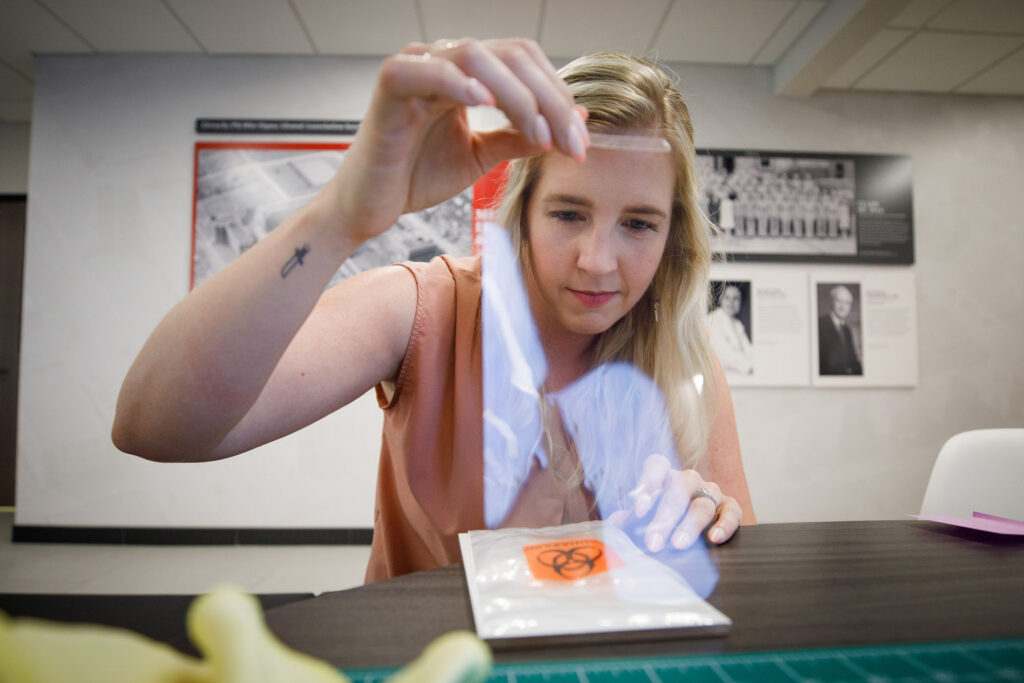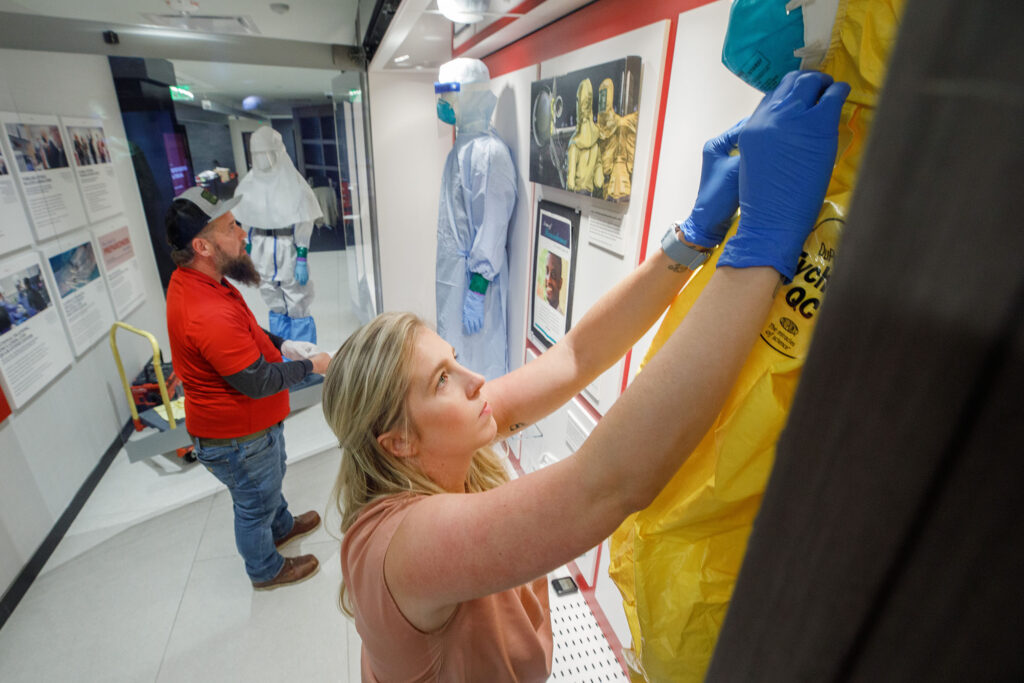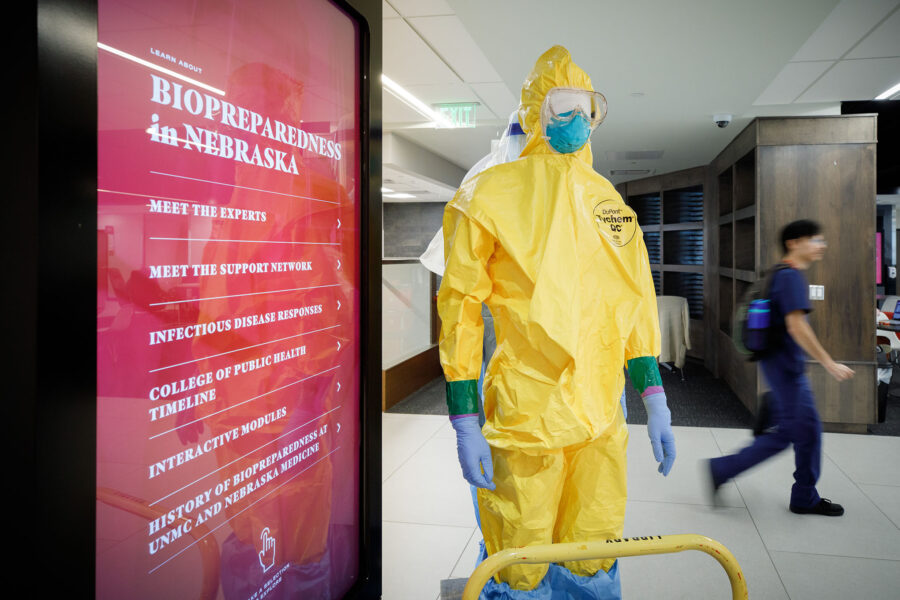As initial plans for UNMC’s Wigton Heritage Center came together, the concept always envisioned an exhibit to highlight the med center’s biopreparedness expertise.
By early 2020, special collections and archives staff at the McGoogan Health Sciences Library were even ready to start working on an Ebola display.
But as the emerging pathogen of COVID-19 started sweeping the globe, then-Dean Emily McElroy met with the staff to put the idea on hold: “This is a great initiative, but the biopreparedness team is about to be really busy.”
Years later, the concept for that display is becoming a reality – having been shaped by the trials of the COVID pandemic and a history that is as fresh as yesterday.
The “Biopreparedness in Nebraska” exhibit officially opens for public viewing today (June 19) at the Wigton Heritage Center. In a museum-level display, the exhibit shows and tells visitors the story of how an academic medical center and its clinical partner in middle America became global leaders in biopreparedness and biosecurity response.
It tells of UNMC and Nebraska Medicine offering extraordinary care for Ebola patients and providing steady guidance through the COVID pandemic. It recognizes the originator of the vision – Phil Smith, MD, the founding medical director of the Nebraska Biocontainment Unit upon its establishment in 2005. And it highlights the personal stories of the providers on the unit’s team who stepped forward to the most dangerous of health care’s front lines.

Darby Kurtz, assistant professor with the McGoogan Library, archivist and public historian, said the exhibit will provide a wealth of information to people who visit the display cases.
“What we’re providing is a great way to share their amazing work with the local community, as well as the international community, who may not be active in infectious disease and medicine,” Kurtz said. “It’s just really exciting.”
The exhibit provides an array of artifacts, photos and informational panels to document the med center’s biopreparedness history. On display are two different sets of Ebola personal protective equipment, including a powered air-purifying respirator, or PAPR, mask that could be pulled out of the exhibit if the need ever arose.
Also on display is one set of COVID PPE and two different COVID test kits. One kit is from early in the pandemic, sent out by the Centers for Disease Control and Prevention, that UNMC and Nebraska Medicine lab personnel found to be faulty. The other is a PCR saliva test developed by the UNMC Emerging Pathogens Laboratory.
It includes a resolution by the NU Board of Regents acknowledging the Nebraska Biocontainment Unit for its service during Ebola, a binder with nationally adopted protocols on biological and chemical agents disseminated by the med center and a remote stethoscope used for patients with highly infectious diseases, which minimizes the amount of direct contact for providers.
Different panels walk visitors through creation of the Nebraska Biocontainment Unit; the Nebraska Public Health Laboratory; the Global Center for Health Security; the National Training, Simulation and Quarantine Center; the National Emerging Special Pathogen Training and Education Center; and the Center for Preparedness Education.

Kurtz said another focus is on the oral histories collected by library staff from 19 campus representatives and three family members to document events. Visitors can access the interviews through a digital display.
“There’s just so much information in these oral histories,” Kurtz said. “We have a plethora of stories to tell.”
Those oral histories offer personal, in-depth insights into the people behind the 2014 care of Ebola patients in the unit and the early 2020 COVID care of Americans who had been working in Wuhan, China, and passengers from the Diamond Princess cruise ship.
See the McGoogan Health Sciences Library’s online exhibit of “Biopreparedness in Nebraska.”
Shelly Schwedhelm, executive director of emergency management and biopreparedness at Nebraska Medicine, said 2014 was an emotional time. Schwedhelm said she as the nursing director and Dr. Smith as the medical director carried the burden and the worry about anyone on the team getting ill from Ebola.
Through the display, Schwedhelm said, people will see through words and visuals what the team was thinking during the episode, what they wore and how they behaved – “which is to provide extraordinary patient care against all odds.”
Schwedhelm said the display offers a way for people to take the journey with the biopreparedness team – and learn what motivates a team of health care workers to engage in such a dangerous mission.
“We strongly felt it was our mission to care for Americans in trouble – Americans with the deadliest pathogen in the world,” she said. “And if not us, then who?”
Christopher Kratochvil, MD, currently UNMC’s interim vice chancellor for external relations, who has held several leadership roles over the years in biopreparedness, said the vision to create the biocontainment unit showed Dr. Smith’s innovative mindset. But, Dr. Kratochvil said, it also demonstrated the importance of fighting for the unit’s development and having the diligence over time to maintain it at a high level.
Dr. Smith’s pioneering efforts set the foundation for the robust health security work going on today at UNMC and Nebraska Medicine through the Global Center for Health Security and the College of Public Health, Dr. Kratochvil said. It also set the stage, he said, for the future of the medical center in Project NExT.
Said UNMC Chancellor Jeffrey P. Gold, MD, “To say that Dr. Phil Smith was ahead of his time is an understatement. His vision, perseverance and passion for making a difference in the lives of others helped advance a complicated field and, in the process, save countless lives.
“After creation of the Nebraska Biocontainment Unit, he knew the day would come when the need would be there. We spent nine years waiting for the world to notice us.
“I’m thrilled that we now have this exhibit to give current and future UNMC students, faculty and staff and the community at large the full picture of the necessity of infectious disease treatment and control – and the expertise here in Nebraska.”
Angela Hewlett, MD, medical director of the Nebraska Biocontainment Unit, said the biocontainment unit’s team is “nothing short of extraordinary” and its accomplishments can be attributed to Dr. Smith’s leadership and foresight.
Said Dr. Hewlett, “It is truly wonderful to see the rise from local recognition of our unique biocontainment facility and dedicated team to serving as an international leader in biopreparedness – documented as a part of history in this new exhibit and to see Dr. Smith so aptly honored for his pioneering work in the field.”
Kathleen Boulter, nurse manager of the Nebraska Biocontainment Unit, said the exhibit is a tremendous honor for the unit team.
“It shows how our perseverance with training and being prepared really mattered when it was needed,” she said. “I hope everyone feels the pride we do for this display.”
Emily Glenn, dean of the McGoogan Health Sciences Library, said it has been an honor for the McGoogan Library to collect, preserve and share the artifacts of the Nebraska Biocontainment Unit and the stories of such a dedicated unit team.
“We believe this is the first exhibit of its kind, perhaps in the world, to focus on health care providers and the impact of biopreparedness and biocontainment work on their families,” Glenn said. “We are proud to illuminate Nebraska’s biocontainment leadership through Wigton Heritage Center tours and online exhibitions.”

Kudos to all for pulling this display together – it’s truly an historic effort.
Congratulations to everyone who worked so hard on this exhibit with special thanks to those who shared their stories. Dr. Smith and the entire team are an inspiration to the world.
Great work. Proud of the team.